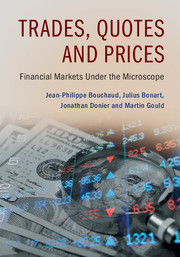Book contents
- Frontmatter
- Dedication
- Contents
- Preface
- Acknowledgements
- PART I HOW AND WHY DO PRICES MOVE?
- PART II LIMIT ORDER BOOKS: INTRODUCTION
- PART III LIMIT ORDER BOOKS: MODELS
- PART IV CLUSTERING AND CORRELATIONS
- PART V PRICE IMPACT
- PART VI MARKET DYNAMICS AT THE MICRO-SCALE
- PART VII ADVERSE SELECTION AND LIQUIDITY PROVISION
- PART VIII MARKET DYNAMICS AT THE MESO-SCALE
- PART IX PRACTICAL CONSEQUENCES
- Appendix
- Index
PART VI - MARKET DYNAMICS AT THE MICRO-SCALE
Published online by Cambridge University Press: 26 February 2018
- Frontmatter
- Dedication
- Contents
- Preface
- Acknowledgements
- PART I HOW AND WHY DO PRICES MOVE?
- PART II LIMIT ORDER BOOKS: INTRODUCTION
- PART III LIMIT ORDER BOOKS: MODELS
- PART IV CLUSTERING AND CORRELATIONS
- PART V PRICE IMPACT
- PART VI MARKET DYNAMICS AT THE MICRO-SCALE
- PART VII ADVERSE SELECTION AND LIQUIDITY PROVISION
- PART VIII MARKET DYNAMICS AT THE MESO-SCALE
- PART IX PRACTICAL CONSEQUENCES
- Appendix
- Index
Summary
Introduction
In the previous parts of this book, we have addressed the empirical and conceptual aspects of the relationship between order flow and price formation. Let us recap what we have so far: a highly predictable order flow, which is a consequence of traders splitting their metaorders into small chunks due to liquidity shortage, and some observations of how trades impact prices. In this part, we will begin our modelling efforts of market dynamics at the micro-scale by introducing a class of simple models of price formation, often dubbed propagator models. When fitted on data, these models provide a route to computing many different quantities of interest, including the aggregate impact of individual orders and the impact of metaorders.
We will use propagator models to explore two interesting topics. The first topic is how to infer the reaction impact from the observed impact of real trades. By making explicit the relationship between these two types of impact, propagator models make it possible to estimate the reaction impact from the empirical response function, which we have already encountered in Chapter 11. In this view, the prediction component of impact is simply the reaction component of other (past and future) trades. Correlations in the order flow therefore play a central role. As we will discuss in this part, the outcome of such empirical calculations is quite intriguing: the reaction impact of orders is neither permanent (as it decays to zero in the long run) nor transient (as this decay is so slow that it takes an extremely long time to vanish).
The second topic is understanding how prices can remain unpredictable when order flows exhibit strong, long-range autocorrelations. As we discussed in the first part of this book, the signature plot of market prices is nearly flat on all scales, which indicates that price returns are linearly unpredictable. How is this possible when the order flow itself is so predictable? As we will see, the answer stems from the dynamic nature of price impact. By performing detailed calculations, we will show that the slowly decaying reaction impact exactly compensates for the autocorrelation in order flow, so as to produce diffusive prices. We will also present another angle for understanding this fine balance: if the impact of an order is proportional to its surprise, and not just its direction, then by definition prices must be unpredictable.
- Type
- Chapter
- Information
- Trades, Quotes and PricesFinancial Markets Under the Microscope, pp. 245 - 248Publisher: Cambridge University PressPrint publication year: 2018



